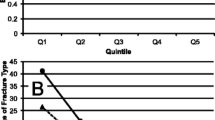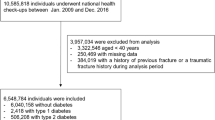Abstract
Summary
This study aims to investigate the role of obesity and diabetes on bone health in a nation-wide cohort of women with high risk of fracture.
Introduction
The role of obesity and diabetes on fracture risk is yet poorly understood. Body mass index (BMI) and bone mineral density (BMD) are strongly correlated; however, patients with elevated BMI are not protected against fractures, configuring the obesity paradox. A similar controversial association has been also found in diabetic patients. Herein, we present a retrospective analysis on 59,950 women.
Methods
Using a new web-based fracture risk-assessment tool, we have collected demographic (including BMI), densitometric, and clinical data (including history of vertebral or hip and non-vertebral, non-hip fractures, presence of comorbidities). We performed a propensity score generation with 1:1 matching for patients in the obese (BMI ≥ 30) and non-obese (BMI < 30) groups, in the diabetics and non-diabetics. Propensity score estimates were estimated using a logistic regression model derived from the clinical variables: age, lumbar spine T-score, and femoral neck T-score.
Results
We found an association between diabetes and fractures of any kind (OR 1.3, 95% CI 1.1–1.4 and 1.3, 95% CI 1.2–1.5 for vertebral or hip fractures and non-vertebral, non-hip fractures, respectively). Obesity, on the other hand, was significantly associated only with non-vertebral, non-hip fractures (OR 1.3, 95% CI 1.1–1.6). To estimate the individual effect of obesity and diabetes on bone health, we ran sensitivity analyses which included obese non-diabetic patients and non-obese diabetic patients, respectively.
Conclusions
Non-obese diabetics had the highest risk of vertebral or hip fracture, whereas obese non-diabetics predominantly had non-vertebral, non-hip fracture’s risk. These results should raise awareness in clinical practice when evaluating diabetic and/or obese patients.



Similar content being viewed by others
References
Kanis JA, Melton LJ, Christiansen C et al (1994) The diagnosis of osteoporosis. J Bone Miner Res Off J Am Soc Bone Miner Res 9:1137–1141. https://doi.org/10.1002/jbmr.5650090802
Hernlund E, Svedbom A, Ivergård M et al (2013) Osteoporosis in the European Union: medical management, epidemiology and economic burden. A report prepared in collaboration with the International Osteoporosis Foundation (IOF) and the European Federation of Pharmaceutical Industry Associations (EFPIA). Arch Osteoporos 8:136. https://doi.org/10.1007/s11657-013-0136-1
Rossini M, Adami S, Bertoldo F, Diacinti D, Gatti D, Giannini S, Giusti A, Malavolta N, Minisola S, Osella G, Pedrazzoni M, Sinigaglia L, Viapiana O, Isaia GC (2016) Guidelines for the diagnosis, prevention and management of osteoporosis. Reumatismo 68:1–39. https://doi.org/10.4081/reumatismo.2016.870
Kanis JA, Hans D, Cooper C et al (2011) Interpretation and use of FRAX in clinical practice. Osteoporos Int 22:2395–2411. https://doi.org/10.1007/s00198-011-1713-z
Adami S, Bertoldo F, Gatti D, Minisola G, Rossini M, Sinigaglia L, Varenna M (2013) Treatment thresholds for osteoporosis and reimbursability criteria: perspectives associated with fracture risk-assessment tools. Calcif Tissue Int 93:195–200. https://doi.org/10.1007/s00223-013-9748-0
Schwartz AV (2016) Epidemiology of fractures in type 2 diabetes. Bone 82:2–8. https://doi.org/10.1016/j.bone.2015.05.032
de Waard EAC, Koster A, Melai T et al (2016) The association between glucose metabolism status, diabetes severity and a history of fractures and recent falls in participants of 50 years and older-the Maastricht study. Osteoporos Int 27:3207–3216. https://doi.org/10.1007/s00198-016-3645-0
Mantovani A, Sani E, Fassio A, Colecchia A, Viapiana O, Gatti D, Idolazzi L, Rossini M, Salvagno G, Lippi G, Zoppini G, Byrne CD, Bonora E, Targher G (2019) Association between non-alcoholic fatty liver disease and bone turnover biomarkers in post-menopausal women with type 2 diabetes. Diabetes Metab 45:347–355. https://doi.org/10.1016/j.diabet.2018.10.001
Vestergaard P (2007) Discrepancies in bone mineral density and fracture risk in patients with type 1 and type 2 diabetes--a meta-analysis. Osteoporos Int J Establ Result Coop Eur Found Osteoporos Natl Osteoporos Found USA 18:427–444. https://doi.org/10.1007/s00198-006-0253-4
Napoli N, Chandran M, Pierroz DD, Abrahamsen B, Schwartz AV, Ferrari SL, IOF bone and diabetes working group (2017) Mechanisms of diabetes mellitus-induced bone fragility. Nat Rev Endocrinol 13(4):208–219. https://doi.org/10.1038/nrendo.2016.153
Merlotti D, Gennari L, Dotta F, Lauro D, Nuti R (2010) Mechanisms of impaired bone strength in type 1 and 2 diabetes. Nutr Metab Cardiovasc Dis 20(9):683–690. https://doi.org/10.1016/j.numecd.2010.07.008
Neumann T, Lodes S, Kästner B, Franke S, Kiehntopf M, Lehmann T, Müller UA, Wolf G, Sämann A (2014) High serum pentosidine but not esRAGE is associated with prevalent fractures in type 1 diabetes independent of bone mineral density and glycaemic control. Osteoporos Int 25:1527–1533. https://doi.org/10.1007/s00198-014-2631-7
Compston JE, Flahive J, Hosmer DW, Watts NB, Siris ES, Silverman S, Saag KG, Roux C, Rossini M, Pfeilschifter J, Nieves JW, Netelenbos JC, March L, LaCroix AZ, Hooven FH, Greenspan SL, Gehlbach SH, Díez-Pérez A, Cooper C, Chapurlat RD, Boonen S, Anderson FA Jr, Adami S, Adachi JD, for the GLOW Investigators (2014) Relationship of weight, height, and body mass index with fracture risk at different sites in postmenopausal women: the Global Longitudinal Study of Osteoporosis in Women (GLOW). J Bone Miner Res 29:487–493. https://doi.org/10.1002/jbmr.2051
WHO | Obesity and overweight. In: WHO. http://www.who.int/mediacentre/factsheets/fs311/en/. Accessed 24 Nov 2017
Bosello O, Donataccio MP, Cuzzolaro M (2016) Obesity or obesities? Controversies on the association between body mass index and premature mortality. Eat Weight Disord 21:165–174. https://doi.org/10.1007/s40519-016-0278-4
Mitchell NS, Catenacci VA, Wyatt HR, Hill JO (2011) Obesity: overview of an epidemic. Psychiatr Clin North Am 34:717–732. https://doi.org/10.1016/j.psc.2011.08.005
Fassio A, Idolazzi L, Rossini M, Gatti D, Adami G, Giollo A, Viapiana O (2018) The obesity paradox and osteoporosis. Eat Weight Disord EWD 23:293–302. https://doi.org/10.1007/s40519-018-0505-2
Curtis EM, Moon RJ, Harvey NC, Cooper C (2017) The impact of fragility fracture and approaches to osteoporosis risk assessment worldwide. Bone 104:29–38. https://doi.org/10.1016/j.bone.2017.01.024
Adami G, Rossini M, Fassio A et al (2020) Comments on Kanis et al.: algorithm for the management of patients at low, high, and very high risk of osteoporotic fractures. Osteoporos Int. https://doi.org/10.1007/s00198-020-05302-6
Reid IR, Ames RW, Evans MC, Sharpe SJ, Gamble GD (1994) Determinants of the rate of bone loss in normal postmenopausal women. J Clin Endocrinol Metab 79:950–954. https://doi.org/10.1210/jcem.79.4.7962303
Reid IR (2010) Fat and bone. Arch Biochem Biophys 503:20–27. https://doi.org/10.1016/j.abb.2010.06.027
Evans AL, Paggiosi MA, Eastell R, Walsh JS (2015) Bone density, microstructure and strength in obese and normal weight men and women in younger and older adulthood. J Bone Miner Res Off J Am Soc Bone Miner Res 30:920–928. https://doi.org/10.1002/jbmr.2407
Yang S, Shen X (2015) Association and relative importance of multiple obesity measures with bone mineral density: the National Health and Nutrition Examination Survey 2005-2006. Arch Osteoporos 10:14. https://doi.org/10.1007/s11657-015-0219-2
Zhao L-J, Jiang H, Papasian CJ, Maulik D, Drees B, Hamilton J, Deng HW (2008) Correlation of obesity and osteoporosis: effect of fat mass on the determination of osteoporosis. J Bone Miner Res 23:17–29. https://doi.org/10.1359/jbmr.070813
Compston JE, Watts NB, Chapurlat R, Cooper C, Boonen S, Greenspan S, Pfeilschifter J, Silverman S, Díez-Pérez A, Lindsay R, Saag KG, Netelenbos JC, Gehlbach S, Hooven FH, Flahive J, Adachi JD, Rossini M, Lacroix AZ, Roux C, Sambrook PN, Siris ES, Glow Investigators (2011) Obesity is not protective against fracture in postmenopausal women: GLOW. Am J Med 124:1043–1050. https://doi.org/10.1016/j.amjmed.2011.06.013
Prieto-Alhambra D, Premaor MO, Fina Avilés F, Hermosilla E, Martinez-Laguna D, Carbonell-Abella C, Nogués X, Compston JE, Díez-Pérez A (2012) The association between fracture and obesity is site-dependent: a population-based study in postmenopausal women. J Bone Miner Res Off J Am Soc Bone Miner Res 27:294–300. https://doi.org/10.1002/jbmr.1466
Sornay-Rendu E, Boutroy S, Vilayphiou N, Claustrat B, Chapurlat RD (2013) In obese postmenopausal women, bone microarchitecture and strength are not commensurate to greater body weight: the Os des Femmes de Lyon (OFELY) study. J Bone Miner Res Off J Am Soc Bone Miner Res 28:1679–1687. https://doi.org/10.1002/jbmr.1880
Sukumar D, Schlussel Y, Riedt CS, Gordon C, Stahl T, Shapses SA (2011) Obesity alters cortical and trabecular bone density and geometry in women. Osteoporos Int J Establ Result Coop Eur Found Osteoporos Natl Osteoporos Found USA 22:635–645. https://doi.org/10.1007/s00198-010-1305-3
Barbour KE, Zmuda JM, Boudreau R, Strotmeyer ES, Horwitz MJ, Evans RW, Kanaya AM, Harris TB, Bauer DC, Cauley JA (2011) Adipokines and the risk of fracture in older adults. J Bone Miner Res Off J Am Soc Bone Miner Res 26:1568–1576. https://doi.org/10.1002/jbmr.361
Corbeil P, Simoneau M, Rancourt D, Tremblay A, Teasdale N (2001) Increased risk for falling associated with obesity: mathematical modeling of postural control. IEEE Trans Neural Syst Rehabil Eng 9:126–136. https://doi.org/10.1109/7333.928572
Stein EM, Strain G, Sinha N, Ortiz D, Pomp A, Dakin G, McMahon DJ, Bockman R, Silverberg SJ (2009) Vitamin D insufficiency prior to bariatric surgery: risk factors and a pilot treatment study. Clin Endocrinol 71:176–183. https://doi.org/10.1111/j.1365-2265.2008.03470.x
Himes CL, Reynolds SL (2012) Effect of obesity on falls, injury, and disability. J Am Geriatr Soc 60:124–129. https://doi.org/10.1111/j.1532-5415.2011.03767.x
Nevitt MC, Cummings SR (1993) Type of fall and risk of hip and wrist fractures: the study of osteoporotic fractures. The study of Osteoporotic Fractures Research Group. J Am Geriatr Soc 41:1226–1234. https://doi.org/10.1111/j.1532-5415.1993.tb07307.x
Janghorbani M, Van Dam RM, Willett WC, Hu FB (2007) Systematic review of type 1 and type 2 diabetes mellitus and risk of fracture. Am J Epidemiol 166:495–505. https://doi.org/10.1093/aje/kwm106
Janghorbani M, Feskanich D, Willett WC, Hu F (2006) Prospective study of diabetes and risk of hip fracture: the nurses’ health study. Diabetes Care 29:1573–1578. https://doi.org/10.2337/dc06-0440
Author information
Authors and Affiliations
Corresponding author
Ethics declarations
The study was conducted according to the protocol 1876 approved by our local Ethics Committee, in accordance with the 1964 Helsinki declaration and its later amendments or comparable ethical standards. Informed consent was waived because encrypted retrospective information was used.
Conflicts of interest
Maurizio Rossini reports personal fees from AbbVie, Abiogen, Eli-Lilly, Merck Sharp & Dohme, Novartis, Sanofi, UCB, outside the submitted work. Giovanni Adami, Davide Gatti, Giovanni Orsolini, Francesco Pollastri, Eugenia Bertoldo, Ombretta Viapiana, Francesco Bertoldo, Alessandro Giollo, and Davide Gatti have no conflict of interest to declare.
Additional information
Publisher’s note
Springer Nature remains neutral with regard to jurisdictional claims in published maps and institutional affiliations.
Rights and permissions
About this article
Cite this article
Adami, G., Gatti, D., Rossini, M. et al. Risk of fragility fractures in obesity and diabetes: a retrospective analysis on a nation-wide cohort. Osteoporos Int 31, 2113–2122 (2020). https://doi.org/10.1007/s00198-020-05519-5
Received:
Accepted:
Published:
Issue Date:
DOI: https://doi.org/10.1007/s00198-020-05519-5




